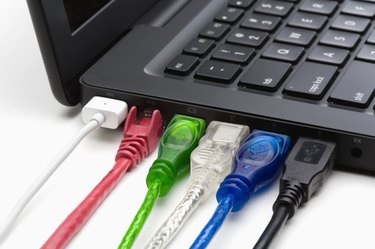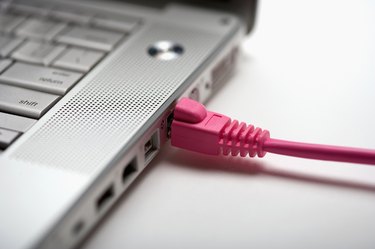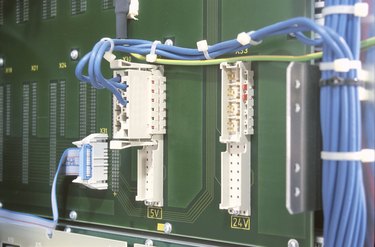
Ethernet is a common method for networking computers to each other and the Internet. Universal Serial Bus (USB) is an interface for connecting devices to a computer. Both of these interfaces can be used to connect to the Internet. Internet access speed is one of the top considerations when choosing between Ethernet and USB.
Function
Video of the Day

Both Ethernet and USB are designed for the two-way communications. Because USB is a generic interface, it can be used for connecting to the Internet through a USB-capable device, such as a cable modem. Most computers are equipped with several USB ports, making USB a popular option for connecting computers to the Internet.
Video of the Day
Speed Comparison

The basic metric for comparing Ethernet versus USB speed is data transfer speed, measured in megabits per second (Mbps).
As of 2009, there are two major versions of USB. The latest, USB 2.0, is capable of transferring data at a rate of 480 Mbps. The older USB 1.1 has a maximum data transfer rate of 12 Mbps. Many older computers are equipped with the slower USB 1.1 ports.
Ethernet comes in a variety of speeds, typically from 10 Mbps to 1 gigabit per second (Gbps), but most commonly 100 Mbps. 10 Gbps and 40 Gbps Ethernet speeds are currently under development.
Gigabit (1 Gbps) Ethernet is more than twice as fast as USB 2.0. In reality, both Gigabit Ethernet and USB 2.0 can transfer data far faster than most consumer Internet Service Providers can deliver it.
Benefits

In environments with multiple computers, Ethernet can be used to create a local area network (LAN) through a hub or switch that allows the computers to communicate with each other. Setting up computers on a LAN makes it possible to share files, play networked games, and access network attached devices, such as printers and network attached storage. Setting up a LAN also allows all the computers to connect to the Internet directly instead of sharing the Internet connection of a single connected computer.
For environments with a single computer with no Ethernet port, using USB 2.0 offers simplicity and no additional cost.
While Gigabit Ethernet currently offers little benefit for connecting to the Internet for most consumers, it provides the fastest option for communication among computers connected in a LAN. In environments where the LAN is used heavily, such as networked games and media sharing, Gigabit Ethernet provides fast data transfer speeds, lower latency in games, and improved performance in media players and other applications that use files shared over the LAN.
Considerations

Ethernet networking requires each computer to have a Network Interface Card (NIC), connected through a hub or switch. For computers that do not have an Ethernet port, this requires extra equipment, a free slot inside the computer to install a NIC, and the complexity of researching, purchasing and installing the NIC and additional equipment.
Warnings

One of the benefits of USB is the ability to connect multiple devices on the same port. However, if too much data are being transferred through a single port, the devices may compete with each other, affecting the performance of the Internet and connected devices.
When setting up an Ethernet LAN, the network will only be as fast as the slowest device. Pay careful attention to equipment choices. If choosing Gigabit Ethernet, make sure all the NICs and the network switch are all rated for Gigabit Ethernet. Network switches provide better performance than network hubs.